In part 1, we finished off with a poster ordering the red guards of the cultural revolution to disperse into the countryside, or in other words, breaking them up to avoid turning the cultural revolution into a civil war. Mao was central in launching that revolution, and would be central in ending it, backed by the People's Liberation Army, which was fed up with teenagers looting their armories.
With the demise of the red guards, the cultural revolution proper came to an end. While Mao remained in power, there were still people trying to climb the party ladders, either to gain supreme power themselves, or to get in line ahead of Mao's eventual death. The power struggles in the Communist party thus carried on until a bit after Mao's death in 1976.
This power struggle would be echoed in many of the propaganda posters of the time. You'll see a few examples of the propaganda warfare that went on between different people and factions, and believe me when I say that this is only a fraction of the available material dealing with this or that party member being a capitalist, a bastard or a counter-revolutionary.
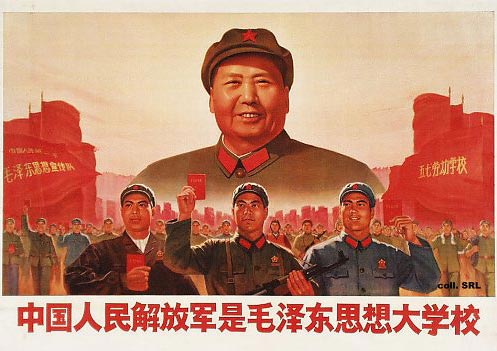
1969 - The Chinese People's Liberation Army is the great school of Mao Zedong thought
Though the Cultural Revolution was a solid disaster, Mao kept going and remained the most elevated and venerated poster boy of Chinese propaganda. Mao's somewhat idealized likeness, coupled with the Little Red book, were potent symbols backing his prestige, and were spewn across China with particular intensity after 1968. The relatively modest amount of Mao posters in this post does not fully reflect this, quite simply because I expect you might get bored after resting your eye on his kind, fatherly face for the umpteenth time.
I remember this particular poster as one of the fist Chinese propaganda posters I ever really noticed, the first that stuck in my mind. Everyone are so focused, so clearly geared towards one common goal, presumably as laid out in the Little Red. Naturally, I could not resist importing this image into MS Paint, painting pirate hats, mustaches and goatees on everyone. Try it, it's fun.

1969 - The invincible thought of Mao Zedong illuminates the stage of revolutionary art!
You might remember Madame Mao from part 1, or Jiang Qing which is her actual name. Well, she's back. Some say she never left. And they're right at that. Anyway, seeing as she was originally an actress, supposedly of average skill, directing the more distinctly cultural issues was something she took easily to. Like everything else at the time, matters of music, stage performance and so on were all best instructed using the universal handbook and remedy, the Little Red, which Jiang is seen holding.
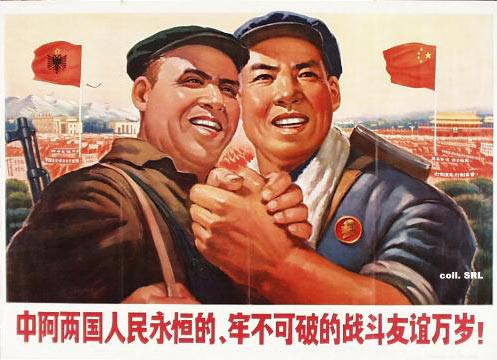
1969 - Long live the eternal and unbreakable friendship in battle between the people's republic of China and Albania
Following the second world war, all of Eastern Europe fell behind the "iron curtain" of the Soviet Union. Albania and Jugoslavia, run by Enver Hoxha and Josip Tito respectively, were exceptions, retaining various degrees of independence from Moscow. Hoxha at first aligned with the Soviet Union, while Tito quickly fell out with Stalin. Stalin repeatedly tried to assassinate Tito, whereupon the latter sent Stalin a frank letter:
"Stop sending people to kill me. We've already captured five of them, one of them with a bomb and another with a rifle (...) If you don't stop sending killers, I'll send one to Moscow, and I won't have to send a second."
The western powers were terribly worried about Soviet satellite states popping up around the globe, like in Cuba, Vietnam, Ethiopia and so on. They may have worried about the same thing with regard to the People's Republic of China, but during the cold war, there wasn't really much to fear, mighty Albania was one of very few allies of communist China. Hoxha wasn't terribly pleased about Stalin's successor, Nikita Khrushchev, and from the late 1950's Albania started moving away from the Soviet Union, towards an alliance with China.
By the time of the printing of this poster, there was no doubting which communist camp Albania belonged to, as this poster clearly illustrates. Notice the MASSIVE sledgehammer-hands of these two buddies!
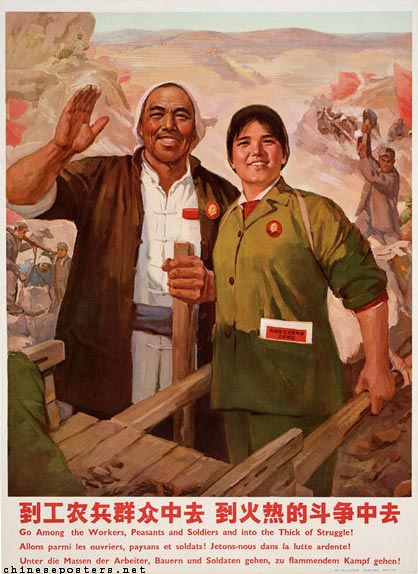
1970 - Go among the workers, peasants and soldiers and into the thick of the struggle!
An export poster, printed in Mandarin, English, French and German. Among the rebellious students of western Europe of the 60's and 70's, Maoism became a popular ideology. Stalin, and to some degree his successors, had made Soviet style communism unattractive, while Maoism appeared fresh and untainted. As we've seen with the Great Leap Forward and the Cultural Revolution, that was far from the case, but a combination of genuine and faked ignorance allowed many to study the words of Mao's Little Red without worrying too much about its dark sides.
My native Norway was home to a particularly rabid bunch of Maoists, organized in the secretive AKP (m-l) party. They were by most accounts a very small party (they never revealed how many members they had), but at the same time terribly loud and visible. Seeing as the party advocated armed revolution, and just as disturbingly, hailed Stalin while seeing his successors as counter-revolutionaries, you can hardly be surprised.
This poster echoes an ideal which some of these "m-l'ers" tried to follow, something called self-proletarization. Inspired by Mao closing higher education and dispersing intellectuals and students to do some "real" work, these Norwegian students abandoned their education and tried turning themselves into labourers.
In an industrialized country like Norway, the labourers would be the revolutionaries, and thus, to be part of the revolution, the students had to get away from their future bourgeoisie careers and get their hands dirty. Many gave up on that project, but a few stuck with it and can still be found labouring away in Norway's slowly shrinking industrial sector.
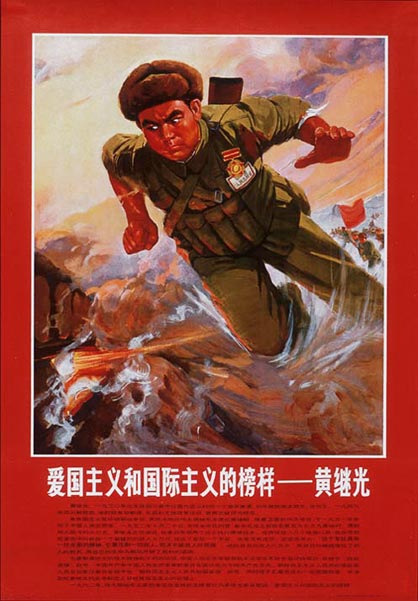
1970 - A model of Patriotism and Internationalism
This pouncing fellow is Huang Jiguang, a celebrated hero of the Korean War. Having expended all his ordnance during an attack on an American machine gun pit, Huang flung himself unarmed at the position. The attack succeeded, but Huang was killed. A popular role model seen in posters up until recent years, he's typically seen in a similarly dramatic posture leaping fearlessly into the fire.
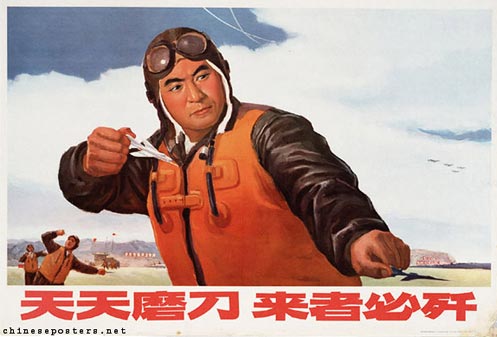
1970 - Sharpening the knife day after day, intruders must be annihilated
... or as I would have preferred the message, "Resolutely play with toy planes every day to defend the socialist Motherland and Mao Zedong Thought".You can hardly help laughing, or at least giggling a little at the sight of a grown man in full flight gear playing so determinedly with toy planes. I suppose it's one way of saving jet fuel, but honestly, is it really suitable in propaganda material meant to encourage the pilots?
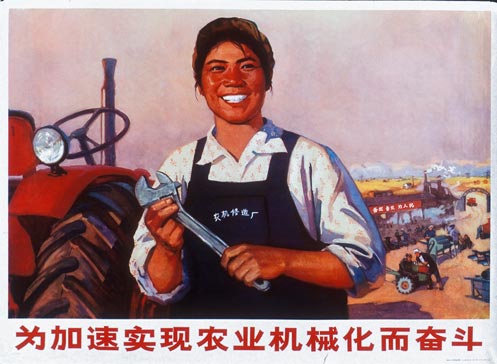
1970 - Struggle to increase the mechanization of agriculture
What a smile! There's something wonderful about this girl's exuberant, dazzling smile being provoked by the thought of increased agricultural mechanization. The viewer is left to guess whether it's the quality of the wrench, the pleasures of driving a tractor or the general thought of mechanization which is the key factor.
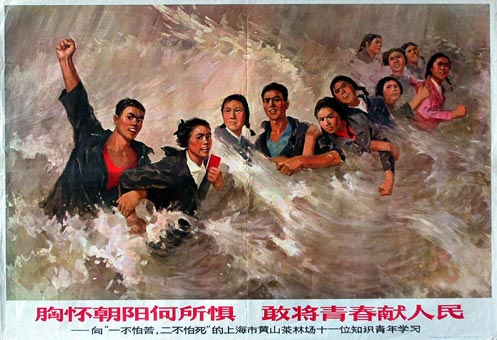
1970 - What is there to fear when one's heart is filled with the morning sun? They dared to devote their youth to the people. Let's learn from the spirit of the 11 educated youths of Shanghai's Mount Huangshan Tea and Forest Farm: "Fear neither hardship nor death."
In 1969, half a million Chinese supposedly subdued a tidal wave using Mao's Little Red. With the girl in focus here holding that book in her hand, I'm guessing this is a propaganda depiction of that event. If one is to believe the claims made about the book in this period, it would seem we are dealing with nothing less than the most powerful book in the world. The mere presence of the book, or reading a few passages could solve any problem.
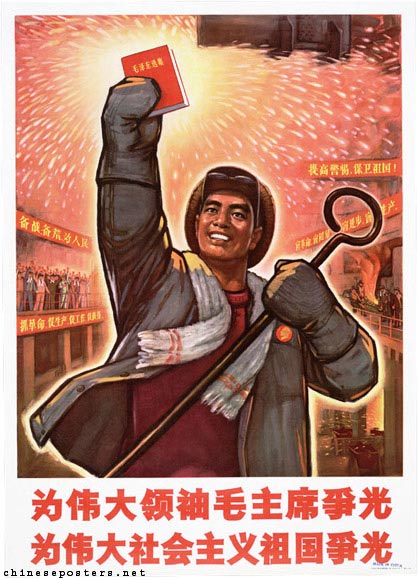
1970 - Win honor for our great leader Chairman Mao, bring credit to our socialist motherland
Another case of red book magic, this particular copy radiates cascades of melted steel, to the cheers of the workers in the plant. To the degree that molten metal can be pleasant, I find this poster a very pleasant looker. The steel eruption from the Little Red is very smoothly painted, creating a halo effect which is also applied to the working hero in the poster, resulting in a very effective framing.
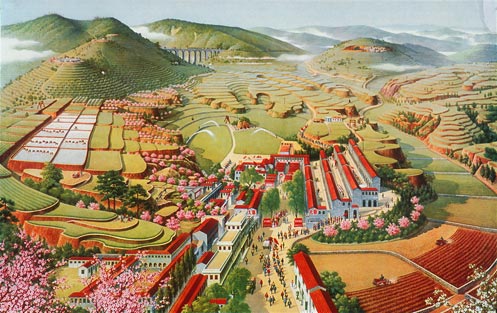
1970's - Dazhai
You might remember the Daqing oil fields mentioned in part 1 as a propaganda model example of an industrial city. This marvelously detailed painting shows Daqing's agricultural twin, Dazhai. Located in the poorly irrigated mountain slopes of Shanxi province, Dazhai was far from an ideal location for a communist farmer's paradise.
But according to communist party legend, a bunch of farmers decided, completely from their own initiative, to reshape the landscape by terracing the hillsides and bringing in water via aqueduct. This massive undertaking was all done by communally organized farmers using their bare hands only.
While it was eventually revealed that the villagers had in fact gotten a great deal of help in this project, including the use of machinery, it did not stop Dazhai from becoming one of the People's Republic most visited tourist attractions in this period. Visitors in the millions, sponsored by the state, travelled to Dazhai to learn and emulate the success at home.
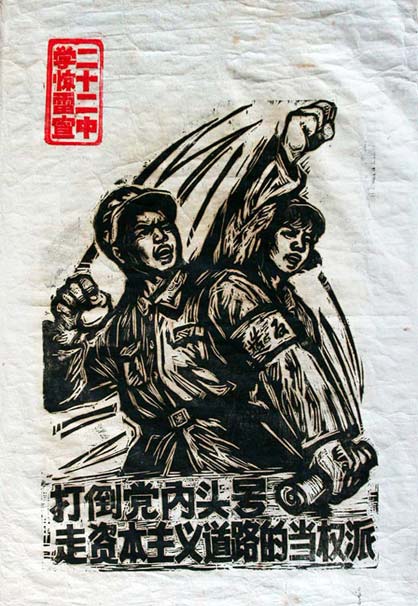
1970 - Down with the leading capitalist roaders now in power within the party
As mentioned in the first part of this series, simple and dramatic posters in red, black and white with a rustic look were a trademark of the Cultural Revolution. The people directing the revolution were also to a large extent the ones behind the continued use of this style after the revolution proper had ended; Mao and his clique.
More moderate, pragmatic party officials like Deng Xiaoping and Liu Shaoqi would be the typical targets, and I wouldn't be surprised if they are the purported capitalists this poster speaks about. The fact that Shaoqi had died in captivity the previous year would not make a difference since his death was kept an official secret for many years.
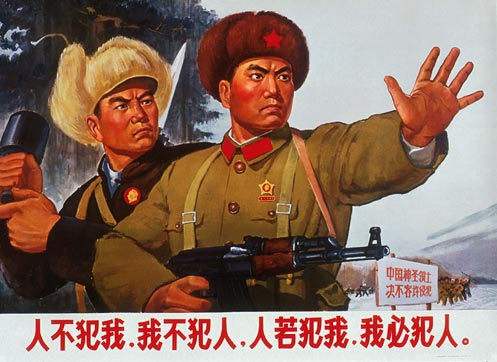
1970 - We will not attack unless we are attacked; if we are attacked, we will certainly counterattack
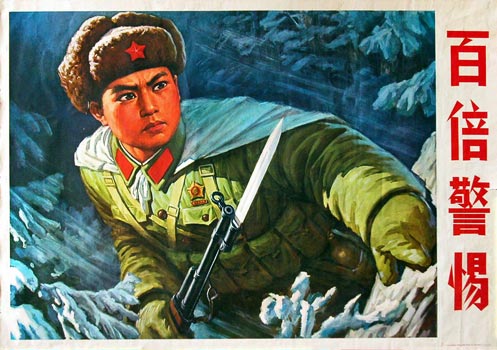
1971 - One hundred times vigilant
It's interesting to note that a large portion of Chinese posters showing PLA soldiers on post, show them in a snowy environment. It could just be a coincidence, but more likely, it reflects the People's Republic's foreign relations situation at the time - the prime enemy not being capitalist USA to the east but the fellow communists of the Soviet Union to the north.
A low intensity border war existed between the two giants at the time, something US president Richard Nixon and his famous National Security Advisor, Henry Kissinger, were eager to exploit. Seeing an opportunity to gain a new ally against the US' prime enemy, the Soviet Union, Kissinger travelled under the utmost secrecy to Beijing in 1971 to discuss their common interests.
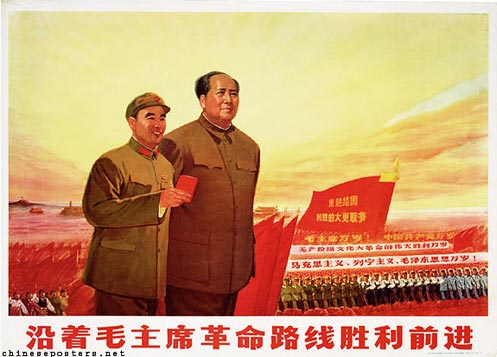
1971 - Advance victoriously while following Chairman Mao's revolutionary line
The little fellow by the side of Mao's towering presence is Lin Biao. Originally a communist military leader during the civil war, Biao would experience a brief rise to the uppermost echelons of Chinese politics, and then literally, a crash. In 1969, he had become second in command after Mao, and was regarded as Mao's chosen successor. In September 1971 however, in a strange turn of events, Biao wound up dead in a crashed PLA Air Force jet in eastern Mongolia.
The official story is that Biao had planned a coup d'etat under the dramatic codename "Project 571". The plan had been discovered and Biao had fled with his family in a jetplane with insufficient fuel, and thus crashed en-route to the Soviet Union. There are good reasons to doubt the complete truth of this official account, but the Chinese authorities still keep a tight lid on the story, so the event is due to remain shrouded in darkness for a good while.
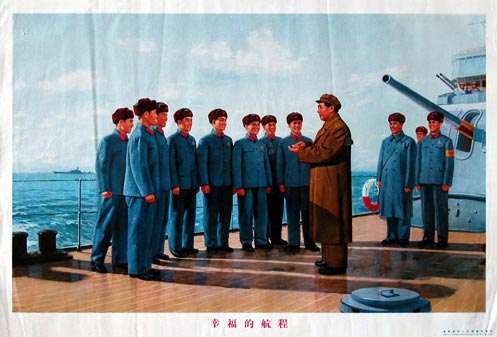
1971 - Happy voyage
There's a naive charm to this poster. The short and sweet title, combined with the way these marines are standing about quite informally in the presence of the great leader, makes it appear more like a schoolmate telling a story in the schoolyard than the demi-god of the People's Republic being present.
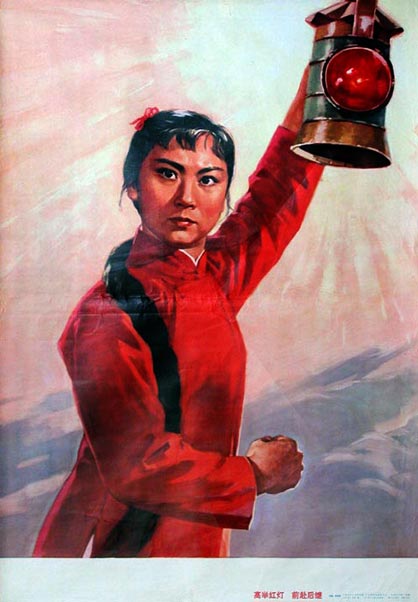
1971 - Hold aloft the red lantern
One aesthetic aspect of propaganda posters which I find interesting is the postures and expressions typically seen in the people. They'll quite often fall into one of two categories, exuberantly happy or disturbingly determined. The happy people will often be happy about something seemingly trivial, like the girl with the tractor and wrench earlier in this post, while the determined folks will look like caricatures.
This is a good case study in that regard. While this girl does not sport the kind of facial expression that makes her appear ready to explode due to over-determination, her posture is a bit ridiculous. Look at her right arm and fist. Nobody does that in reality unless they're trying to be funny, which leads us to something which should be obvious when it comes to propaganda; it's not real.
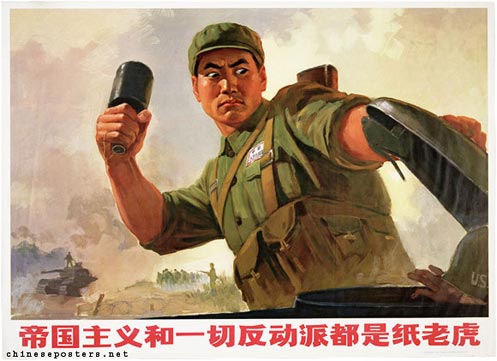
1971 - Imperialism and all reactionary forces are paper tigers
I love the paper tiger phrase. Being a European, I often have problems understanding Chinese symbols, sayings and manners, but this one seems within my grasp. While the concept is ancient, Mao interpreted the US, and later the Soviet Union to be the great paper tigers. They appeared big and threatening, but were really of little substance and would crumble like paper if pushed.
This scene is taken from the Korean war, you may notice that the helmet of the soldier in the tank carries US insignia. In that regard, the Korean war is sort of a bad example of the US being a paper tiger, seeing as the war ended in a status quo, without the US crumbling in any obvious way.
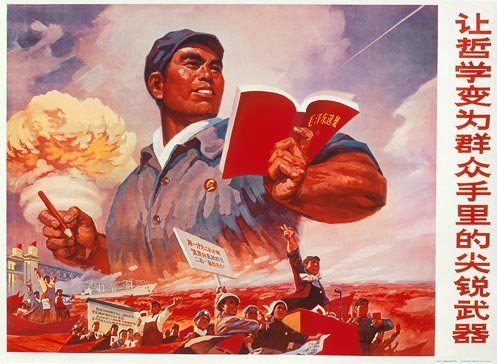
1971 - Let philosophy be transformed into a sharp weapon in the hands of the masses
I don't recall ever seeing a nuclear mushroom portrayed in such a positive way. From the composition of this poster, it seems like everything else practically grows out of the nuke, as if that's THE driving force behind the Chinese revolution.
Again, it's really all about the great power of the Little Red, in this case carried forth by a giant of a man, equipped with the most ridiculously proportioned underarm I've ever seen.

1971 - Long live Chairman Mao
Notice anything strange about their teeth? Everyone seem to be lacking the lower teeth. Those with open mouths seem to only have upper teeth while the rest are lacking a horizontal split between their upper and lower teeth, their mouths seem to be equipped with one massive tooth block.
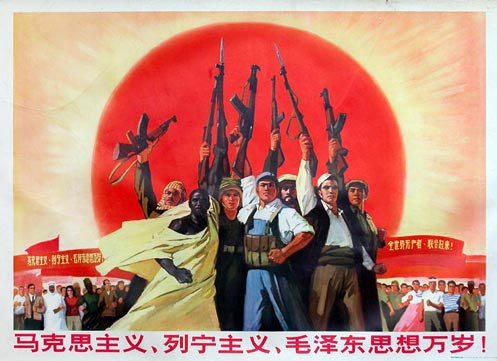
1971 - Long live Marxism, Leninism and Mao Zedong Thought!

1971 - Proletarians all over the world unite!
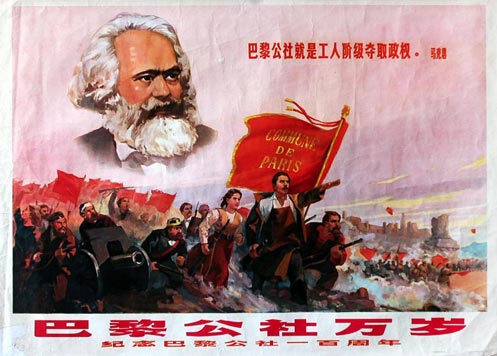
1971 - Long live the Paris Commune
Another three posters focusing on the situation abroad, the first two dealing with then-contemporary third world issues, while the third one is a historic commemoration from the 100th anniversary of the Paris Commune. After a humiliating war defeat at the hands of the Prussian army (soon-to-be Imperial Germany), the radical workers of Paris rose in revolt against France's erstwhile leader, the mediocre Emperor Napoleon III.
This uprising, from which name communism is taken, was probably more akin to how Karl Marx imagined the socialist revolutions of the world would look than the successful revolutions in Russia and China which would follow much later. To Marx's frustration, the commune ended in bloody surpression after two months.
There was one country in Europe which Marx could not possibly see having a socialist revolution. This was Russia, the one country which in fact did see a successful revolution against the old system. Marx was sure that the industrialized countries like Britain, France and Germany would be the ones to rise in rebellion against the old system, NOT predominantly rural countries like Russia and China.
At the time of the Nazi attack on the Soviet Union in 1941, Stalin was still thinking that the greatest conflicts lay in western Europe. He was waiting for the capitalist countries of western Europe to devour each other, whereupon the Soviet Union would swoop in and complete the European revolution. Boy was he wrong.
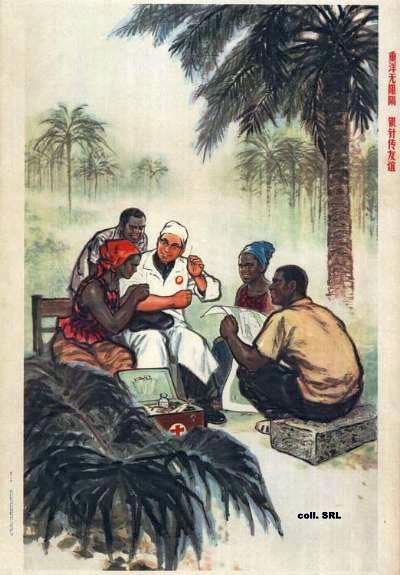
1971 - Seas and oceans are not separated, the silver needle passes on friendship
From 1965 onwards, thousands of medically trained Chinese were ordered into the countryside to bring basic healthcare to the country's huge rural population. Due to them often not wearing shoes, they eventually came to be called "barefoot doctors". This poster apparently shows one such doctor administering vaccines somewhere in Africa. While in fact wearing shoes, there's no doubt he's in a rather rural area, thus in essence making him a barefoot doctor.
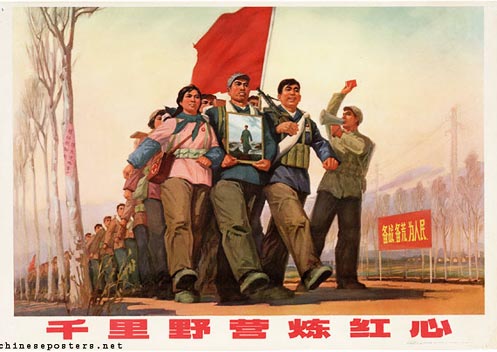
1971 - To go on a thousand "li" march to temper a red heart
Part 1 of this series featured the extensively reproduced painting of Mao walking towards Anyuan. I mentioned that in addition to it being distributed on its own, it was also integrated in other material, something this poster is an example of.
A "Li" is an ancient Chinese unit of measure for length, one which has varied greatly through history, but is nowadays standardized as 500 meters. That means this poster is a encouragement to go on a 500 kilometer march, or 310 miles, which I'd say is respectable.

1971 - We will definitely free Taiwan!
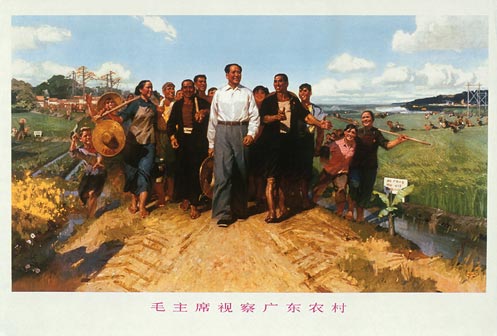
1972 - Chairman Mao inspects the Guangdong countryside
Why bundle these two posters together? The themes of both are clear enough, but the connection takes a bit of explaining. Taiwan's status had been a sore point in diplomacy (or lack thereof) between the People's Republic, the US and the Republic of China (Taiwan).
As I've mentioned, Henry Kissinger travelled secretly to Beijing in 1971, and in 1972, that visit bore fruits with Nixon's week-long visit to Beijing, this time in public. When they met, one of the first remarks from Mao was that "The small issue is Taiwan; the big issue is the world", and he would soon guarantee that the People's Republic would not take Taiwan by force.
When I think about Mao and 1972, the image that immediately springs to mind is in no way resembling the smiling, healthy and gentle looking character seen in this second poster. Rather, I think about his appearance in Oliver Stone's 1995 film "Nixon". In one of the films most memorable and harrowing scenes, an aging Mao is seen meeting Nixon, disposing of all pleasantries and calling things as he sees them. "You are too modest Mr. Nixon. You are as evil as I am." he comments. While Mao was without doubt a cruel character, I'm doubtful as to whether this exact conversation did in fact take place.
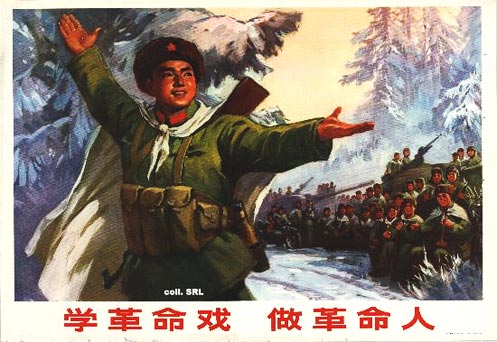
1972 - Study revolutionary plays to become a revolutionary
Again we see PLA soldiers stationed in a snow covered spruce forest. This time, they don't seem as vigilant as earlier, caught up as they are becoming better defenders of the socialist motherland by watching this improvised play.
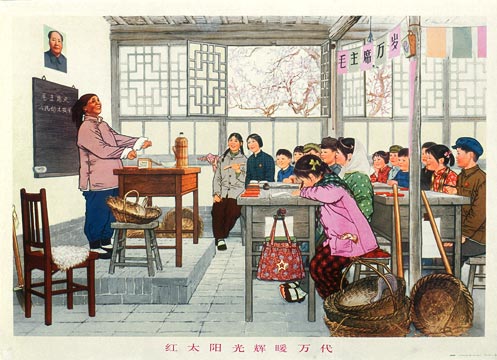
1972 - The Radiance of the Red Sun warms many generations
Mao's health deteriorated in the early 1970's and he withdrew from everyday politics, remaining however a powerful symbol of prestige for those of his backers who continuously struggled for power in China, particularly to determine who would become the undisputed top dog once Mao himself passed.
Beyond use as a symbol for strengthening certain people's power, Mao's image was still a potent unifying symbol for most Chinese, being still the "great leader", even if he wasn't doing too much leading at the time.
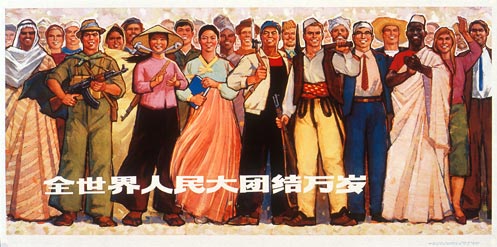
1973 - Long live the Unity of the People of the World
I know I've talked a lot about teeth so far, so I'll make this the last time. There is something remarkable about the depiction of human teeth in some of these posters. Thin, symmetrical slots, impeccably white blocks of solid ice. I'm sure most of you have noticed. I have no idea what the background for this is, I'm sure it's some old cultural thing, deeply ingrained in the soul of China. If any of you readers have a clue about this aspect of Chinese propaganda, do let me know!
Beyond the teeth, I really like this poster. It may just be because I was raised in a home were international solidarity was stressed as important, but this gathering of all sorts of happy people, well, it just makes me happy! I should also note that I find the graphic work here quite excellent, with a sort of ordered chaos coupled with a pleasant use of colours and contrasts.
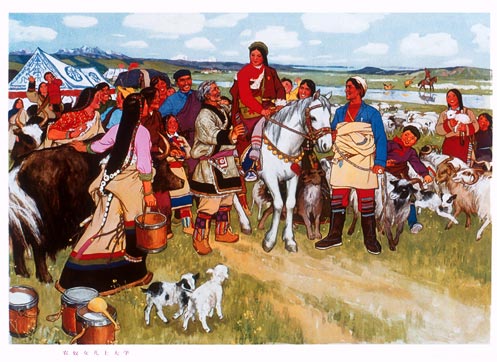
1973 - Tibetan woman goes to University
We now touch on one of the touchiest subjects when it comes to post-revolutionary China. After chasing the nationalists off the mainland, the People's Republic wasted little time in occupying (or reclaiming, according to its own arguments) Tibet, finishing this off in 1951. A great uprising in 1959 coupled with the problems caused by the great leap forward left at least several hundred thousands dead in Tibet.
The Tibetan spiritual leader, and prior to the invasion also its temporal leader, the Dalai Lama, fled to India. Books such as Heinrich Harrer's "Seven years in Tibet" (and its film adaptation), and even more, the Dalai Lama himself, has gathered a huge amount of attention to the fate of a people who number no more than 10 million, perhaps as few as 5.
Stemming from official sources, this poster of course celebrates the positive sides of Chinese involvement in Tibet, here in the matter of education. Prior to the invasion, Tibet was by all accounts a medieval country, and a closed one at that, with only a mere handful of foreigners allowed in.
The modernization of Tibet is one argument the People's Republic likes to use to counter claims of China's suppression of the Tibetans and their culture, with the recent completion of a very complicated railway link to China proper being one example. In any case, it doesn't look like Tibet will be re-gaining its independence anytime soon, with China bounding forward and the Dalai Lama recently telling his countrymen to forego any hopes of an independent Tibet.
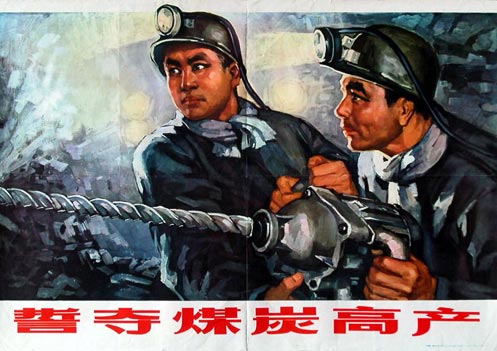
1973 - Vow to maximize coal production
Returning to the more mundane, it still can't be claimed that this is not an important matter. Keep in mind that China for a long time has been the world's greatest coal producer by far, and is still heavily reliant on coal for energy. As of 2006, China was responsible for almost 40% of world production.
This particular poster reminded me of Soviet workers hero Alexey Stakhanov, a coal miner whose feats wound up putting him on the cover of Time Magazine in December 1935. Earlier that year, he reported mining 102 tons of coal in 5 hours and 45 minutes, 14 times his quota, and soon followed up with a new record, mining a whopping 227 tons in a shift. He soon became a poster boy and prime example of a good Soviet worker. As often is the case with these highly publicized propaganda cases (like Dazhai), there are indications that the feats were to some degree engineered exactly for their propaganda value.
I don't know if the People's Republic has ever had a particular coal mining hero, but keeping in mind the communist party's love of model people for educational purposes, I wouldn't be surprised if these two guys are just that, coal heroes of the People's Republic.
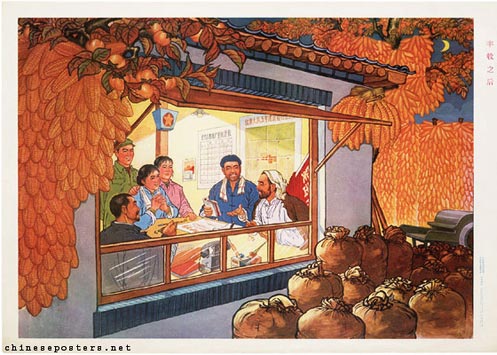
1974 - After the bumper harvest
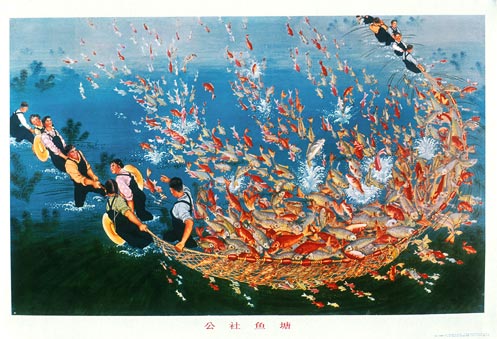
1974 - The commune's fishpond
Two nice examples of works by the so-called Huxian peasant painters. According to the official story, these painters were more or less pulled randomly out of the population and used as examples of the artistic skills which lay dormant within all. They received much publicity and international acclaim for their work, and not unexpectedly, it was later revealed that they had in fact been helped along by professionals. They call it propaganda.
The Soviet Union had similar programs, where talented people from "primitive" minority people would be sent to special academies to develop their innate abilities, without them being "spoilt" by exposure to western civilizations' artistic traditions. Konstantin Pankov was one of these. Of Nenets extraction, Pankov hailed from the far northern areas of Russia, where he had been a hunter on the frozen Taiga. In his short life, he had time to paint some amazing pictures, before being killed near Leningrad, where he fought as a sniper and scout during World War II.
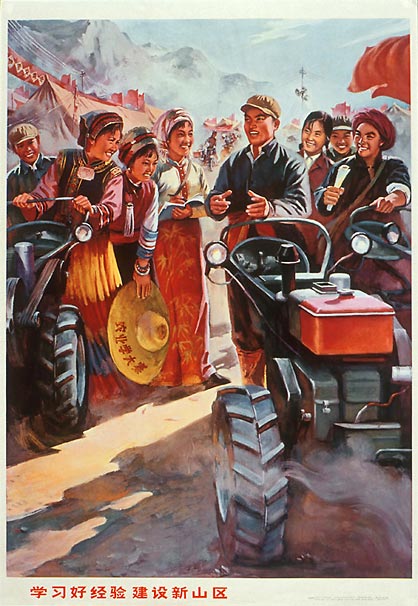
1974 - Learn from the experience of others and develop new mountain areas
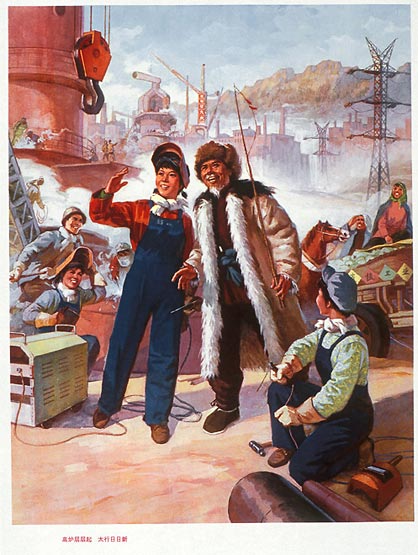
1974 - Tall rising chimneys daily transform the Skyline
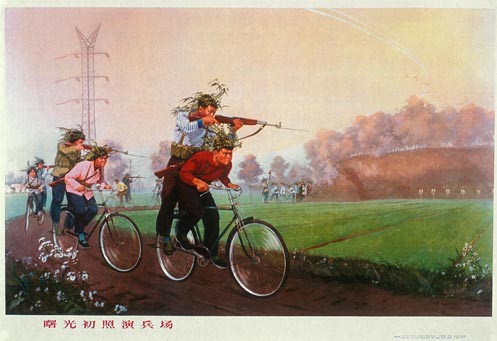
1974 - Military drill at first light
A problem with the city I live in is the amount of broken beer bottles littering the streets, causing frequent flat bicycle tires. To alleviate the problem, I bought a pair of kevlar enhanced tires, which seem to be doing the trick. I like to brag that if someone took a shot at me while I'm on my bike, I'd be impervious, as long as they go for the tires and not myself of course. This poster takes the concept of bicycle warfare to a new level. Well, to the degree that bicycle warfare has ever been a serious concept. In China it was, apparently.
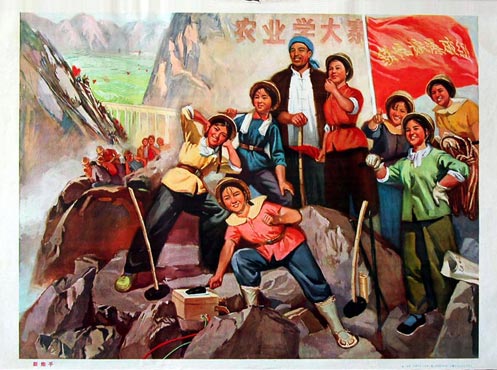
1974 - New dynamiters
I picked this poster for inclusion due to the unmitigated cheeriness of this young crowd. There's something particularly fascinating about the girl in yellow. She seems the most peppy of them all, while at the same time standing seemingly exposed at the edge of a cliff. I guess that's the reason she's the only one covering her ears.
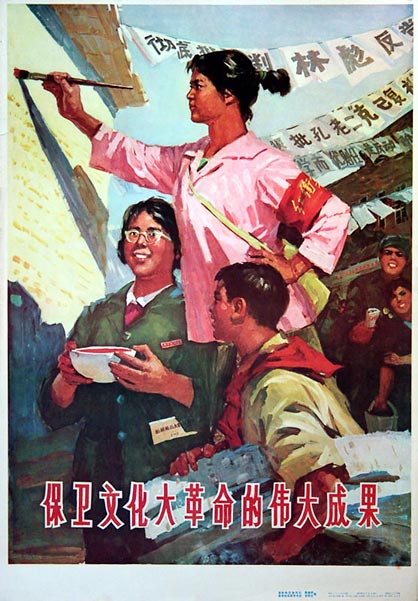
1974 - Protect the grand achievements of the Great Proletarian Cultural Revolution
Around this time, the power struggle in the communist party got real intense. The battle lines appear somewhat diffuse. To simplify, we can say that on the one side, you had the Gang of four, consisting of Mao's wife, Jiang Qiang, Mao's new political darling Wang Hongwen as well as propaganda specialists Zhang Chunqiao and Yao Wenyuan. While the Gang of four were partial to continuing Mao's cultural revolution program, their opponents were of a more pragmatic kind, spearheaded by Deng Xiaoping, who would rather get things back to normal and achieve reconstruction after many years of turmoil.
In between these outer points were the People's Republic's long time premier and master diplomat, Zhou Enlai, as well as Hua Goafeng, who advocated a return to Soviet style central planning. Keeping in mind what I just mentioned about the Gang of four, it seems likely that this poster originates from their circles of power. With effective control over party propaganda and two specialists in the field as part of the group, the Gang's messages came to dominate the People's Republic in the coming few years.
What attracted me to this particular poster was the fabulously feisty look of the young revolutionary in pink. Like all positive propaganda personalities, she puts intense pride into what she's doing, in this case painting some revolutionary slogan on the wall. One less impressive quality in this poster is how the message at the bottom has been outlined in white. Earlier posters would typically have the message printed on the white area beneath the painting in itself, but here, it's been outlined in white and printed inside the painting, and it looks like shit.
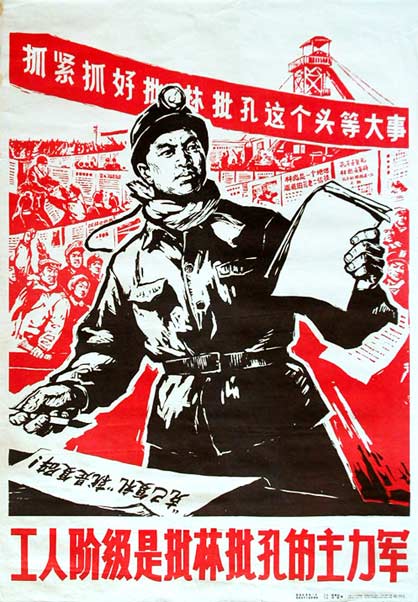
1974 - The working class is the main force in the campaign to denounce Lin Biao and Confucius
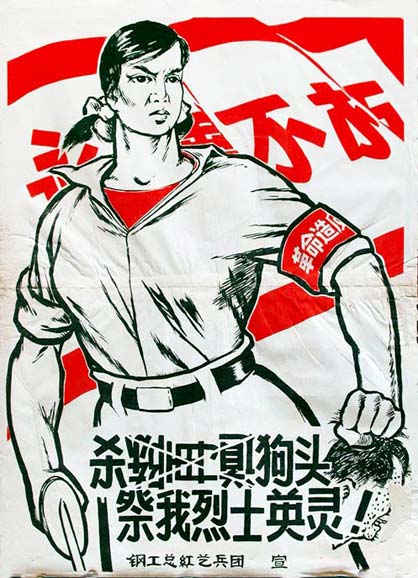
1975 - Kill the bastard Chen Zai-Dao as a sacrifice to the souls of our brave martyrs
You'll recognize the style from the years of the Cultural revolution proper, it was a style that would not go out of fashion until the fall of the Gang of four. The first poster is part of the "Pi-Lin, Pi-Kong" campaign, or translated to english, "Criticize Lin [Biao], Criticize Confucius". Confucian philosophy was identified as an obstacle to modernization during the Cultural Revolution, and the Pi-Lin, Pi-Kong campaign identified Lin Biao in particular as guilty of Confucianism. Keeping in mind that the campaign lasted from 1973-74, and that Lin Biao died in 1971, the campaign may seem a bit misdirected. However, it also had a more indirect traget, Zhou Enlai.
One of the few permanent fixtures in high level Chinese politics, Zhou had been the Premier of the People's Republic since its establishment in 1949, managing throughout to avoid becoming a victim of Mao's frequent fits of paranoia and purging. His high political standing, his pragmatic nature, and not least, his popularity with the people may have been the reasons why the Gang of four wanted to get rid of him, this campaign was a failed attempt at discrediting him with the people.
The second poster, featuring an incredibly butch sword-wielding woman, is directed at PLA general Chen Zaidao. His claim to infamy came in the city of Wuhan in 1967, in the midst of the Cultural Revolution, when he decided to arm the local population against a Red Guard faction trying to gain control of the city. After repeatedly ignoring orders from the central government in Beijing to lay down his arms, an overwhelming military force was dispatched to confront him, whereupon he surrendered and was stripped of his offices. However, he had been rehabilitated by 1972, and apparently, he was seen by some as an enemy of the vilest sort.
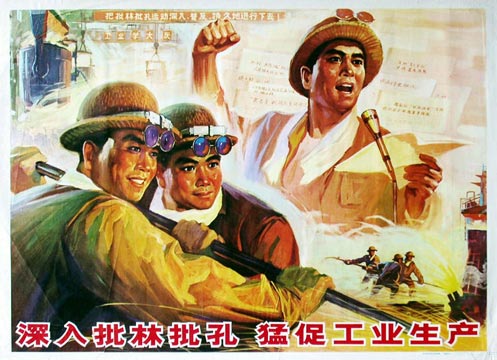
1975 - Intensify the campaign criticizing Lin Biao and Confucius to vigorously promote industrial production
Another fun case of connecting seemingly unrelated themes. On the surface, it's hard to imagine the shouting of anti-Confucian slogans over the factory PA-system is going to do anything but annoy the workers. But, part of the reasoning given for attacking Confucian values in the People's Republic was that it was hindering modernization, and in that regard, Confucianism does not belong among steel workers, because after all, what could be more modern than steel? Quite a lot actually, but you get the point.
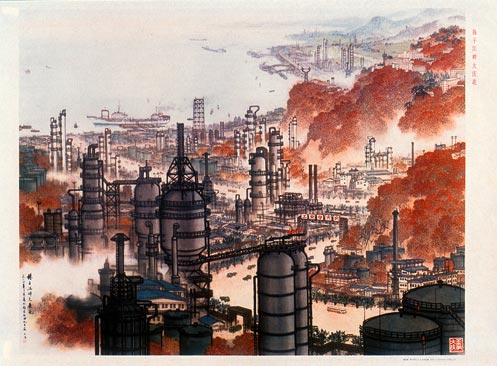
1975 - In industry, study Daqing
I've got a love of things which are ugly, ugly in a beautiful way. I can move through areas of old disintegrating factory halls, warehouses and other rusting crud, and while it's decrepit and depressing, I also get a sort of tingle from it, there's some sort of beauty in it all.
In that regard, this is an amazing painting, presenting the petroleum industry of model city Daqing in all its disgusting smoke and pollution, as a beautiful example, worthy of emulation. While I'm certainly not one to celebrate heavy industry and pollution as an unmitigated positive aspect of modern technology, I do love the graphical glorification of industry often found in communist propaganda.

1975 - Study well and grasp the theory of the dictatorship of the proletariat
One of the concepts of communism which resonates the least with inhabitants of western-style liberal democracies is that of the dictatorship of the proletariat. According to Marx, it was to be a temporary period which would set in after the overthrow of the capitalists, where the workers (the proletariat) would seize power and impose their common rule over society. This would then gradually devolve into a stateless society, devoid of money and classes, the true communist society.
Some Marxists, aware of the stigma accompanying the word dictatorship, prefer to talk about a "workers' democracy". In practice, the distinction between proletarian dictatorship and one-man dictatorship has been somewhat hard to establish, with the Soviet Union lapsing into a proper dictatorship under Stalin, while the People's Republic in periods have seen somewhat wider political influence, a one party state but without one undisputed leader wielding absolute power at all times.

1976 - A new scene in Xiangyangyuan
This scene depicts the reception of a brand new television set for the communal room of a housing project. It was obviously a great occasion, spurring the inhabitants to get out their red banners in celebration.
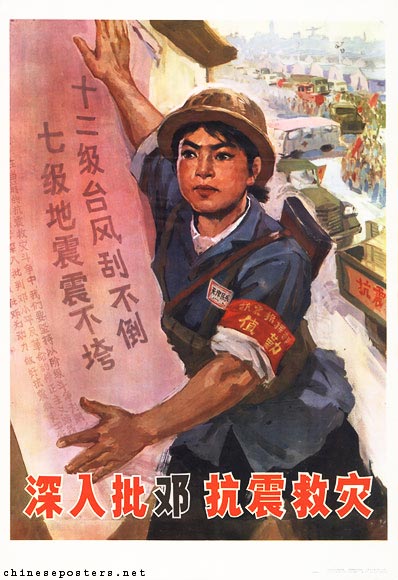
1976 - Deepen the criticism of Deng's earthquake relief work
Of the three great men of the People's Republic during the Cold war, Henry Kissinger writes: "Mao was the visionary, ruthless, pitiless, occasionally murderous revolutionary; Zhou, the elegant, charming, brilliant administrator; and Deng,the reformer of elemental convictions". By early 1976, Zhou Enlai was dead, Mao was clearly on his last legs while Deng Xiaoping, more akin to Zhou than Mao in approach, was still going strong and perceived as a central hindrance to the Gang of Four's ambitions for power once Mao died.
The Gang did not gain much popularity by trying to hinder public mourning of Zhou Enlai when he died early that year. Not relenting, they used the somewhat bungled relief work done after a deadly earthquake struck the city of Tangshan in 1976 to attack Deng. Incidentally, Zhou's successor as Premier, Hua Goafeng, would gain tremendously from his acts during this disaster, a bad omen for the Gang as we'll see.
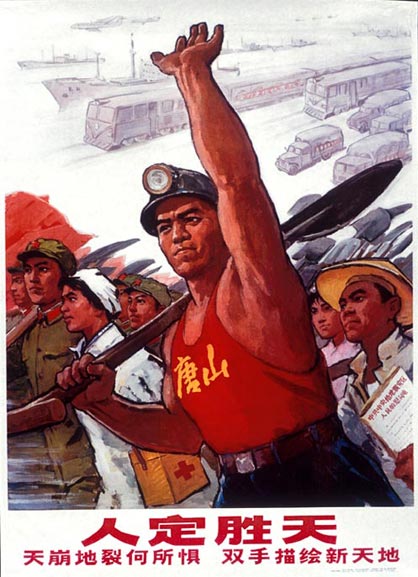
1976 Man can conquer nature
In the west, environmentalism as an ideology has typically first been adopted by left wing political parties, socialist parties among them. Without looking at the actual historical situation, one could easily think that socialists and communist have always been more environmentally responsible than the capitalists and right wingers. Nothing is farther from the truth.
Communists are typically materialists, in the sense that they stress the improvement of living conditions for humans, which will usually happen at the expense of the natural environment. This slogan is as clear as any in that regard, humans can and should subdue and use nature to its own advantage.
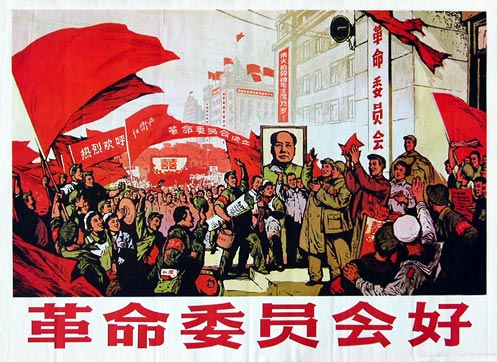
1976 - Revolutionary committees are good
I don't know too much about the background for this poster, but it doesn't seem unlikely that it's the work of the Gang of four, considering the graphic style used, the not-so-subtle inclusion of a Mao portrait, and a message promoting revolutionary committees, something which was also stressed during the Cultural Revolution proper.
Whatever the message, this is a fine poster in my eyes. With heavy use of red and green, coupled with strong contrasts, it's not necessarily pretty, but it exudes a militant optimism that I can't help being torn away by.
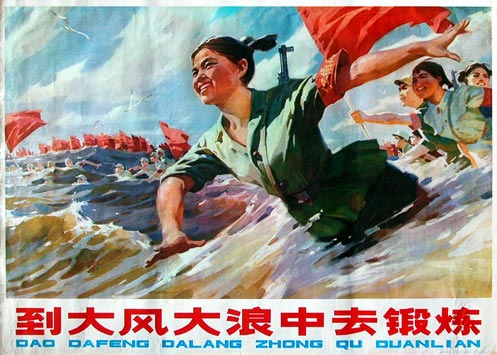
1976 - Toughen yourself by braving the wind and the waves
God I love this poster! Have you ever seen something so optimistic, so airy, so fresh? While the main character here seems to be using auto-levitation to cross the water (a young Jedi perhaps?), I read this poster as alluding to Mao's promotion of swimming as a way for the Chinese people to improve their physical fitness.
Mao had advocated this from a young age, and used himself as an example in 1956 when he swam across the Chang Jiang (Yangtze) river. On the tenth anniversary of that swim, the whole thing was re-done, this time as a huge publicity event to demonstrate the Chairman's undiminished strength.
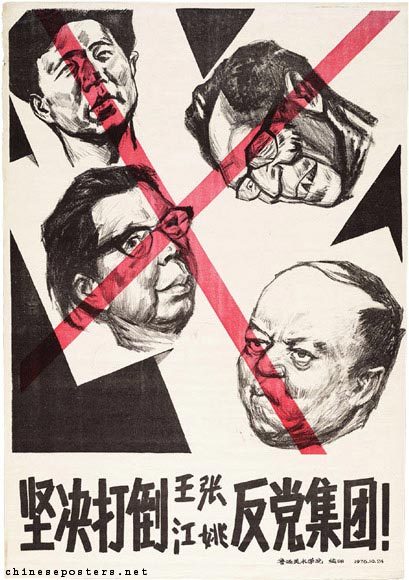
Apx. 1976 - Resolutely overthrow the anti-Party clique of Wang [Hongwen], Zhang [Chunqiao], Jiang [Qing] and Yao [Wenyuan]
The Gang of Four, caricatured in this simple poster, for a long time had a solid grip on the propaganda channels of the People's Republic, which is why their messages have been quite dominant in what you've seen so far.
By 1976 however, their time was nearing its end, and judging by the reactions of the public at their overthrow, they were not particularly popular. In 1981, the gang was subjected to show trials wherein Jiang Qing and Zhang Chunqiao were sentenced to death, but these verdicts were eventually commuted. They were all released from prison between 1991 and 2002, and all have since died. Notably, Jiang Qing, by then sick with cancer, hung herself soon after being released in 1991.
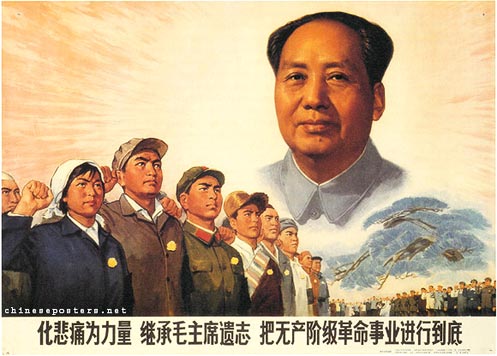
1976 - Turn grief into strength, carry out Chairman Mao's behests and carry the proletarian revolutionary cause through to the end
With the death of Mao on the 9th of September 1976, we come to the end of the second part of this series. With their great backer dead, the Gang of Four were soon arrested on the orders of Premier Hua Goafeng, the apparent successor in power to Mao.
On the matter of Mao's memory, Deng Xiaoping would later make it official policy that Mao had been seven parts right and three parts wrong. That Mao has a controversial legacy is putting it mildly, in his 82 years you'll find plenty of examples of both positives and negatives. For my part, the 30-40 million dead during the Great Leap Forward, the frequent, massive social upheavals initiated by him (most prominently the Cultural Revolution) and the general cruelty he was capable of stands out a lot more prominently than the good he may have caused.
Acknowledgements: This series would never have been possible without the two websites listed beneath. These are the kinds of sites that really make me love the Internet. If you enjoy what you've seen in these posts, spending a few hours (or days) exploring these websites is not a bad way of spending your time
Chineseposters.net - Hosted and designed by the International Institute of Social History in Amsterdam, this website presents the poster collections of the IISH and that of Stefan R. Landsberger. Landsberger is the editor of this utterly fascinating site, which he runs together with co-editor Marien van der Heijden.
It includes a vast collection of imagery, accompanied by a wealth of well written commentary and discussion, putting the imagery in the right context, and I've drawn much on it in the writing of these posts.
Maopost.com - Another huge collection of propaganda. Not as much commentary as in the former, but including an online collection of over 1600 posters in good quality. For those who get hooked on this stuff and have a few hundred dollars to spend, Maopost offers hand painted copies of a selection of posters where you can get a face of your choice (including your own) painted into an otherwise authentic poster.
